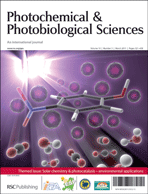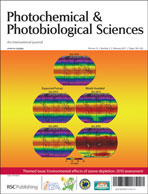 Issue 3 of PPS has been published online. This issue is a collection of papers presented at the 6th European meeting on Solar Chemistry and Photocatalysis: Environmental Applications (SPEA6), which was held in Prague, Czech Republic, in June 2010, and was organized by Josef Krysa and Jaromýr Jirkovsky. The issue is guest edited by Josef Krysa and Sixto Malato.
Issue 3 of PPS has been published online. This issue is a collection of papers presented at the 6th European meeting on Solar Chemistry and Photocatalysis: Environmental Applications (SPEA6), which was held in Prague, Czech Republic, in June 2010, and was organized by Josef Krysa and Jaromýr Jirkovsky. The issue is guest edited by Josef Krysa and Sixto Malato.
The cover of the issue features a paper by Rudolf Słota and coworkers on photocatalysis by TiO2 composites with phthalocyanines and porphyrins. They show the importance of matching the sensitizer to the nature of the TiO2 (micro- or nanocrystalline).
Also in the issue, Maria Antoniadou and Panagiotis Lianos have made a photoactivated fuel cell that uses organic waste to produce electricity. They tested the system on a number of polyols, but suggest that almost any organic substance can be used. The cell uses UVA light, and can run on the UV component of sunlight.
These papers and the rest of the issue can be read online now.











